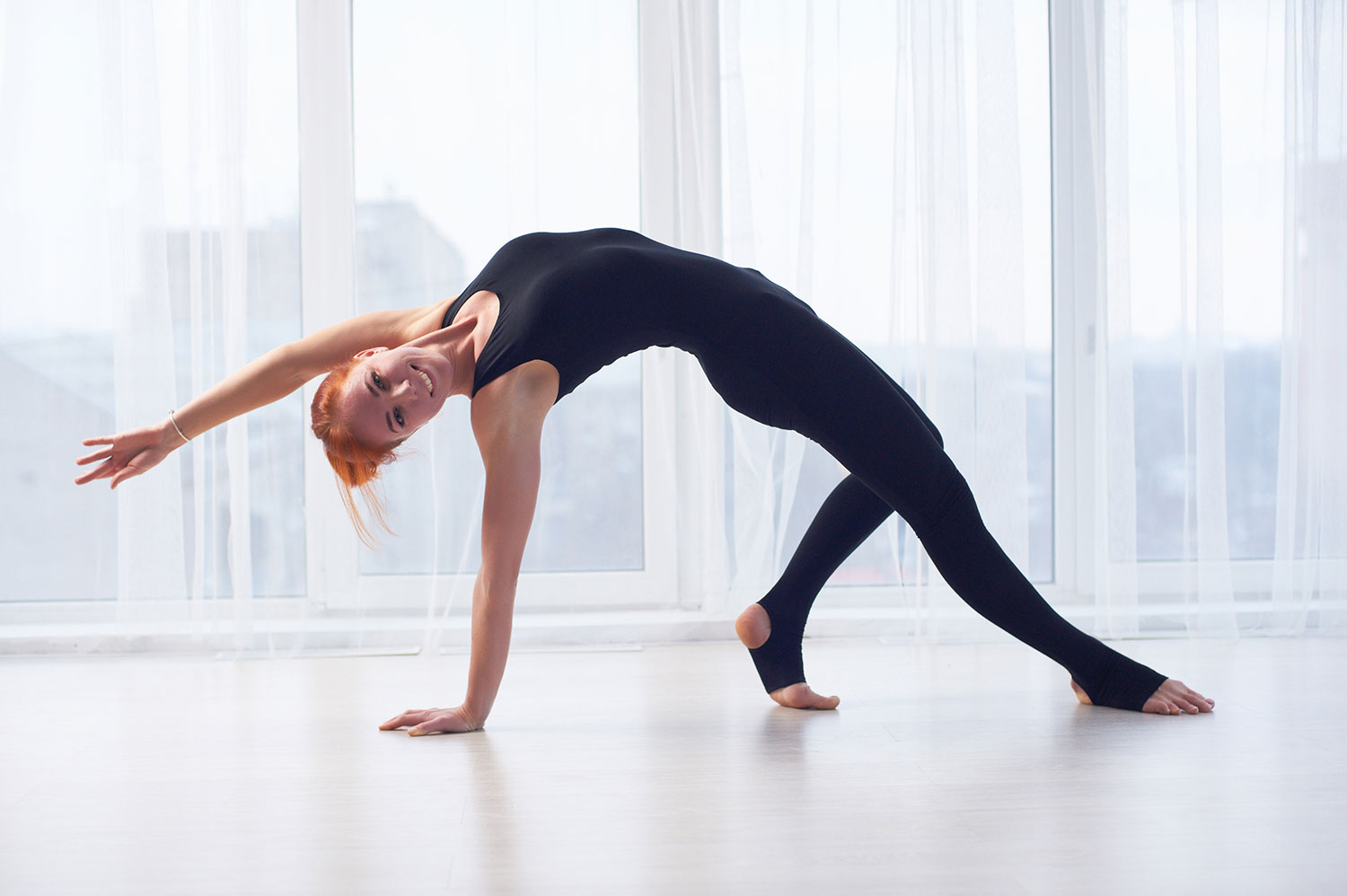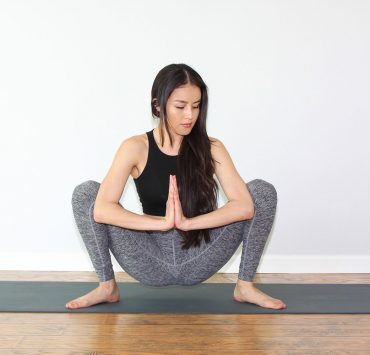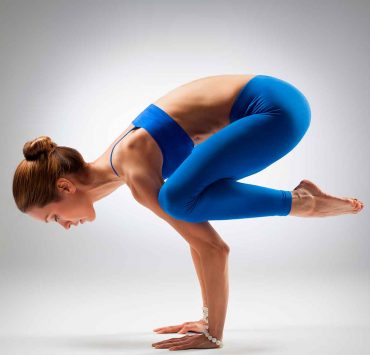
Rose graduated with a degree in Anthropology, which takes her…
Over time, most yogis will find themselves gravitating more toward certain yoga poses. This could be due to a variety of things. Some yoga poses feel good in their individual bodies – for example, someone with long arms may love extended hand-to-big-toe pose (utthita hasta padangusthasana) and someone with shorter arms, who finds it more challenging to achieve a bind, may avoid this pose. Apart from individual preferences, some yoga poses are just more commonly practiced in general. This includes “staple” poses such as any of the poses in the sun salutations like downward facing dog, forward bend, and more.
But there are thousands of yoga poses out there, and many of these more uncommon yoga poses don’t receive the practice time they deserve! Yoga poses can be underrated because they are just not known about, or they may even be common yoga poses that are rushed through because their benefits are not truly understood. The following 15 poses are considered underrated yoga poses.
Dandasana — Staff Pose

It’s easy to see why staff pose (dandasana) is underrated – it just looks like sitting. But this yoga pose is deceptively simple. In Staff pose, the yogi sits on their mat, with legs outstretched. The arms are down by their sides and the hands are planted into the mat, with fingers facing forward. However, this is where things get tricky in staff pose. The yogi must flex their feet, engaging their leg muscles and quadriceps. They lean slightly forward, engaging the deep core muscles. Soon, they might break a sweat. Staff pose is hard work and teaches us not to judge a yoga pose by its outer appearance.
Ardha Pincha Mayurasana — Dolphin Pose

Dolphin pose is often skipped over in favor of its more popular cousin, downward facing dog. The difference between these poses is that in dolphin pose, the yogi lowers onto their forearms, maintaining the downward facing dog position in all other regards. Dolphin pose is perhaps underrated because it’s more difficult to transition between this pose during vinyasas. However, it is worth slowing down and introducing this pose to any yoga practice, because it is extremely effective at strengthening the shoulder girdle. This makes it the ideal pose to strengthen and prepare the body for the inversion forearm stand.
Virabhadrasana III — Warrior III

The Warrior poses are generally not thought of as underrated… that is until you remember the third warrior pose. Warrior III is often glossed over in favor of the more popular Warrior I and Warrior II which are both staples in the sun salutations. However, Warrior III may be the most challenging of all. The pose can be entered from Warrior I, by lifting off the back leg and balancing the torso straight over the front leg, arms and back leg extending in opposite directions. Warrior III is the ideal pose to build heat and tapas in the body. The yogi strengthens their standing leg, works on deep core muscles and hip stabilizers, and practices balance.
Uttana Shishosana — Extended Puppy Pose

Extended puppy pose is a modern yoga pose but still very beneficial. It can be practiced by sitting in child’s pose and walking the arms far forward, and lifting the bottom toward the ceiling. As the yogi gets deeper into the pose, they will feel it opening up the shoulders. Extended puppy pose is one of the only yoga poses that offers a good stretch to the under side of the shoulders, making it unique among yoga poses.
Ardha Matsyendrasana — Half Lord of the Fishes Pose

Half lord of the fishes pose is a very ancient and traditional yoga pose, often practiced in closing sequences such as in the Ashtanga yoga practice. However, it is often skipped over in other yoga classes, perhaps because it involves so much twisting and can be confusing for first timers to enter. To practice this pose, sit on the mat with legs outstretched. Bend the right knee and slide the leg in so the knee is aligned with the center of the body, and the right foot rests on the outside of the left hip. Then, bend the left knee and press the left foot into the mat, on the outside of the right thigh. The left knee should be pointing up toward the ceiling. From here, plant the left hand behind you. Reach the right arm up toward the ceiling, and then bend at the elbow and twist, placing the right elbow against the outside of the upright left thigh. Twist and gaze toward the back of the room. The deep twisting in half lord of the fishes pose helps with detoxification.
Supta Padangusthasana — Reclining Hand to Big Toe Pose

This pose is essentially the reclining version of the more commonly practice hand to big toe pose (utthita hasta padangusthasana). It is practiced by lying flat on your back on the mat. Inhale the right leg straight up toward the ceiling, and find a grasp around the big toes with the right hand. Keep both legs straight and both hips and shoulders pressing into the mat. This pose works on hamstring flexibility, but because it is a reclining pose, it does so in a passive, gentle way.
Marichyasana III — Marichi’s Pose III

Marichi’s pose is another twisting pose from the Ashtanga yoga series, commonly practiced as a closing pose. It is an incredible way to twist into the torso and activate the liver and adrenal glands. To practice Marichi’s pose, sit in staff pose on the mat. Bend the right knee and place the right foot on the mat, right in front of the pubis. Plant the right hand behind you on the mat. Inhale and reach the left arm tall, and exhale and twist, bending the elbow and planting the back of the left arm on the outside of the bent right knee.
Utthan Pristhasana — Lizard Pose

Lizard pose is another yoga pose that was invented in modern times, and is underrated by many yogis, perhaps because they don’t know its name or origins, or consider it more as a ‘stretch’ than a yoga pose. Lizard pose can be thought of as a variation on crescent pose (anjaneyasana). From Crescent pose, the yogi plants their hands on the inside of the front foot. From here, they lower onto the forearms and breathe. Lizard pose is very intense but it is perfect for stretching the hips and activating the second chakra.
Tadasana — Mountain Pose

Mountain pose, or tadasana in Sanskrit, is another example of how looks can be deceiving. In mountain pose, the yogi stands tall at the front of their mat, feet together. Arms are down by their sides, palms facing forwards. From the outside, mountain pose doesn’t even look like a yoga pose – it just looks like standing. For this reason, it is often skipped over in yoga classes, or practiced only very briefly and without attention to its unique challenges. Mountain pose is really an incredible yoga pose for tuning into alignment. By taking a moment here and scanning the body from the feet all the way up the legs, hips, spine, shoulders, neck, and head, the yogi can gain a deeper understanding of their own unique alignment on any given day. This knowledge can then be used to inform adjustments in other yoga poses throughout the practice.
Viparita Karani — Legs Up the Wall Pose

In legs up the wall pose, the yogi’s legs are quite literally up the wall. They lie flat on their back with their bottom pressed against the wall, and the legs resting up against the wall. At first, it can feel awkward to enter this pose, so perhaps that is why it is often skipped over in yoga classes. However, this pose has such a wide range of health benefits that it should be practiced daily, even on its own. By elevating the legs in a restorative posture, the flow of lymphatic fluid is reversed. This detoxifies the body, and is very important because the body’s lymphatic system is what keeps the immune system functioning. It is a powerful pose to practice, particularly after a long day of walking, standing, or sitting, to reverse the effects of gravity.
Camatkarasana — Wild Thing Pose

Wild thing pose is what many yoga teachers refer to as ‘flipping your dog.’ From downward facing dog, the right leg is lifted back and bent at the knee, opening the hip. Lifting off the right arm, the yogi opens up and plants the right foot on the mat, whilst grounding into their supporting left hand and foot. This pose is often not fully taught by yoga teachers, and instead is treated as a transition or brief option to play with downward facing dog pose. Perhaps this could be because wild thing pose is challenging to get into. However, it deserves to be explored as its own individual pose as it can offer a range of benefits, from strengthening the shoulder girdle, to opening the chest and hips, and instilling a sense of playfulness in the practice.
Ardha Uttanasana — Halfway Forward Fold Pose

Like the previous pose, halfway forward fold is often treated merely as a transition and not as a yoga pose in its own rite. To practice this pose, start in a complete forward bend (uttanasana), and lifting the torso up about halfway. The spine should extend straight from the pelvis and the heart should be open. The hands can reach toward the mat, or rest on the shins or even the thighs. Everyone’s halfway forward fold pose will look unique depending on their hamstring flexibility. This is a useful pose for gently working on hamstring flexibility, particularly if a full forward bend is too much.
Padahastasana — Gorilla Pose

While halfway forward fold pose is wonderful for people with tight hamstrings, people who are very flexibile in their hamstrings may need a further challenge. Gorilla pose, or padahastasana, is the ideal pose for individuals who want to increase hamstring flexibility. From forward fold, or uttanasana, the hands are placed under the feet. The tops of the hands press into the mat, and the soles of the feet meet the palms of the hands. Not only is gorilla pose a wonderful pose to increase hamstring flexibility, but it can also provide a nice release for the wrist joints, which are so often put under pressure in vinyasa style yoga classes.
Utkatasana — Chair Pose

Unlike some other more ‘unusual’ poses on this list, chair pose (or utkatasana) is actually very commonly practiced. It is a central pose in the sun salutation B and is taught in most yoga classes. The yogi stands tall on their mat, bends their knees as if they were sitting back in a chair, and reaches the arms up and overhead. However, just because chair pose is a common pose doesn’t mean it isn’t still underrated. This pose, when held for prolonged periods of time, is one of the most effective poses at building heat, or tapas, in the body. It is the perfect remedy to sluggishness and helps move prana, or life energy, through all the limbs. It is a full body yoga pose that strengthens the quadriceps, glutes, back, core, shoulders, and arms. The next time you practice, give a little more time and attention to chair pose and you will reap its benefits.
Savasana — Corpse Pose

The final yoga pose of any sequence is traditionally corpse pose, or savasana. Again, this pose appears to be simple: The yogi lies flat on their back, palms open, closes their eyes, and breathes. Perhaps because it looks so simple on the outside, many people will skip corpse pose in their home yoga practice. However, corpse pose is arguably the most important of all yoga poses in any given practice! It is during corpse pose that the yogi soaks up the physical and mental benefits of the practice, and their body prepares itself to take those lessons off the mat. Corpse pose also helps the yogi eliminate ‘mind chatter,’ by using mindfulness to let go of stray thoughts and focus wholly on the present moment. Corpse pose is a small moment of meditation at the end of practice, that is essential to the tradition of yoga, and should be respected.
Conclusion
If you want to introduce some new and unusual energy to your next yoga practice, try including one of these poses. Whether it’s a new pose you’ve never tried before, or an old favorite that you can breathe new life into, each of these poses is underrated in one way or another.
What's Your Reaction?
Rose graduated with a degree in Anthropology, which takes her understanding of basic human needs to a whole new level. Her intelligence and passion for healthy living is reflected in her written work.














